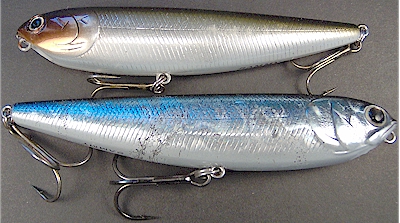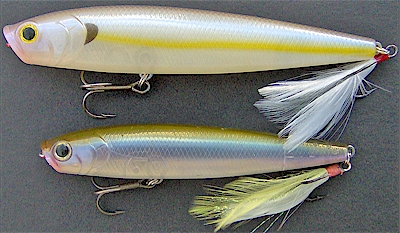(Note: This is part 3 of a 3-part story on Lucky Craft hardbaits. Part 1 covers crankbaits, including 7 lipped and 5 lipless cranks. Part 2 presents 6 of Lucky Craft's best jerkbaits. Part 3 floats 4 of the finest topwater options. Those are my 22 lucky-est choices among Lucky Craft USA's 75 bass models. I hope you'll find a bait or tip or two here that may be lucky for you too!)
Lucky Craft Sammy Series
I wonder who came up with 'walking the dog'? Walking puppy or walking puppet would have been a better name because the Sammy certainly is a puppet. Like Pinocchio, the Sammy is utterly lifeless until you, the puppet master, pull its string.
When given the proper action, the Sammy will zigzag on the surface side to side like a wounded baitfish.
When I cast out, I want the Sammy to make a big splash as it hits the water. I want to trick bass into thinking this big splash was made by another bass that just smacked a shad on the surface. I want bass to hear a big splash, think it was another bass blasting a meal, and see my injured Sammy limping away from the scene of the crime! When bass think other bass are feeding, they get very competitive and want a piece of the Sammy for themselves before other bass get it. They get greedy and lose caution. So I cast out, let it splash loudly like a feeding bass and immediately start the zigzag retrieve with no hesitation. Bass rocket up and belt it!
When bass hit a walking bait, they often miss it. I do not think the bass can clearly see it because of all the surface disturbance. In fact, I have seen many bass swimming along underneath and behind walking baits. Apparently, the bass are trying to get a clear look at it. I do not think they can see it well. Often, the bass will be zigzagging its own head from side to side, trying to get a better look at a walking bait from the left and from the right. Have you ever seen bass do this? They will follow walking baits for a while, trying to get a clear view of them.
When they've seen enough, the bass will boil up behind it and blast a walking bait. Never stop giving it the zigzag action with the rod tip even when a bass is cartwheeling all over it. As I say, they often miss it. If you keep zigzagging, they will belt you two, three, four times until you finally feel solid weight on the rod tip...and the bass is on!
Because bass have such a problem hitting a walking bait, I like to help them out by putting the biggest hooks I can possibly fit on my walking baits without ruining the action. With the Sammy, I will put size #2 hooks on the 3/4 oz Sammy 115. I put a pair of heavier, longer shank #4 hooks on the 1/2 oz Sammy 100.
Even with bigger hooks on them, bass will still miss walking baits when they swipe at them. With the Sammy, the heavier hooks slow down the frantic, splashy action a little. The heavier hooks give the Sammy a bit slower, more stable zigzag that leaves a vee wake on the surface. I think this slower action helps bass hit them more accurately and the larger hooks are harder to avoid.
Sammy Actions
With the bigger hooks, I give action to the Sammy in three ways:
I give very short movements of only 3 to 4 inches to the rod tip, and I turn the reel handle slowly so the Sammy comes across the surface at a medium pace. The only thing I like to see is one inch of the Sammy's nose twitching back and forth, which leaves a rippling vee trail wake behind it. The rest of the body stays underwater. This is the retrieve I use in open water away from shore or cover. I use this retrieve when active fish can not be seen breaking the surface. It is the most life-like retrieve of all, but takes more time because it is moderately slow. This is a finesse fishing presentation, and can really pull fish up from deep water when nothing else will.
When active bass can be seen breaking the surface here and there, you do not need to go so slow. I do the same as above (move the rod tip 3 to 4 inches) but I turn the reel handle faster so the Sammy zigzags across the surface at a fast pace. This fast pace seems better for fish that are up on top competing with each other for food. Still, I usually only want to see the nose of the Sammy come out of the water on this faster retrieve for active fish, and the heavier hooks help keep the rest of the body lower in the water. Instead of or in addition to heavier hooks, you can also stick a couple of Storm SuspenDots or SuspenStrip adhesive weights under the tail to make it lay lower.
When I fish up against shoreline or cover, I do something different. In this case, I use longer, slower movement of the rod tip, and I want to see the entire side of the Sammy come out of the water on every zig or zag. I try to make this happen in slow motion so the Sammy kind of hangs there between each zig or zag. The whole Sammy should move side to side - not just the nose. It looks very much like a dying fish. This slow, sweeping tactic keeps the Sammy hanging next to cover where bass are hiding. It draws them out. Almost pausing in between feeble flips and dying flops is fine. Retrieves #1 and #2 above would go past shoreline cover too quickly - not hang there long enough to infuriate bass to come out of their hiding holes deep inside the cover like tactic #3.
Lucky Craft Sammy 100Model: Sammy 100 | Lucky Craft Sammy 115Model: Sammy 115 |

Sammy 100 (top) and Sammy 115.
When to Use Sammy 100 or Sammy 115
The Sammy 100 is by far the most popular Sammy size across the USA. The 100 out-sells other Sammy sizes by a wide margin. Indeed, the Sammy 100 is one of the most popular of all Lucky Craft lures of any kind. So if you were going to rely on or wanted to try only one size of Sammy, the 100 is certainly it.
The bigger Sammy 115 is a distant second in terms of popularity. There are two smaller (65 and 85) and one larger (128) sizes of Sammy also. All do work well, but the 65, 85 and 128 are not as popular as the 100 nor even the distant second-best seller, the Sammy 115.
In terms of my own personal favorite size, it is the Sammy 115. It casts extremely well. When replaced with #2 hooks, the Sammy 115 becomes very special to fish in deeper, calm water using a slow, gentle walk-the-dog action that makes the nose barely twitch without splashing as described above.
I favor the bigger Sammy 115 for covering deep water on big lakes and large reservoirs.
I downsize to the Sammy 100 in shallower water (where fish can be spookier), on smaller bodies of water, or whenever the fish show no interest in the 115, that's when I'll break out the Sammy 100.
Lucky Craft Gunfish 95Model: Gunfish 95 | Lucky Craft Gunfish 115Model: Gunfish 115 |

Gunfish 115 (top) and Gunfish 95.
The Gunfish is unique in shape and different in action compared to other walking baits like the Sammy. The Gunfish has a more spitty, slashy, frantic action. It skates its body side to side rather than roll or waddle like other walking baits. Many anglers tend to work the Gunfish faster and more frantically than they would a Sammy. With its flat, dished face, the Gunfish throws a splash like a popper, and walks the dog like a Sammy. So it combines features of both a popper and a walking bait into one. However, it is first and foremost a walking bait, so the best action is to keep it walking, not pop-and-pause it. Just keep it walking, and it will splash and spit from its mouth as it sashays side-to-side. Get a good, consistent cadence going, and don't stop the action, especially not when a fish is slashing at it. Just keep it coming like nothing's happening, until the striking fish finally hooks itself.
The Gunfish throws more surface commotion than a Sammy, so the Gunfish may be at its very best when there's a little wind smear or surface chop rather than a slick calm day. However, give it a try any time, and let the fish tell you what they want.
Both the Gunfish 115 and 95 are top-selling Gunfish models. The 95 and 115 are about equal in sales, and they both work well.
One more thing to keep in mind is that fish see poppers and walking baits every day on every body of water. What fish don't see all the time is the Gunfish with its little different action. Because it isn't so commonly used, you'll often see Lucky Craft's top tour pros opt for the Gunfish whenever there's a topwater bite. Reason is, even at the top tour level, fish haven't really seen the Gunfish before and most pros (except the LC pros) aren't going to be throwing it. In many places, the Gunfish is still a fresh new lure that fish have not seen much, and there's something to be said for that.
Lucky Craft Topwater Color Considerations
I like the natural baitfish colors of topwaters for all water clarities from clear, stained or dark. I have always found that natural baitfish colors work with topwaters under most conditions. I have not really found many conditions with topwater baits where brighter or bolder colors work better than natural ones. Of course there are always exceptions, but you can't go wrong with the natural colors - white-bellied or semi-translucent 'ghost' colors with darker backs, optionally with silver or gold flash sides. Those will work most of the time. Some of the Lucky Craft colors along these lines include:
#052 Aurora Black
#237 Ghost Blue Shad
#238 Ghost Minnow
#250 Chartreuse Shad
#254 MS Herring
#262 Laser Clear Ghost
#268 Pearl Ayu
#270 MS American Shad
About the only time that natural baitfish colors will be a disadvantage is when you are targeting bass, but other species like stripers keep hitting your topwater lures. The trick is to try an unorthodox color then, find one that stripers won't hit as eagerly, thereby allowing bass more time to crash the party.
#247 MS Black is a beautiful 'magic scale' (MS) black finish that is popular for night fishing- or any time there's low light or dark water.
Also, once you get an old, beat up Sammy or Gunfish, you can spray one with a light coat of flat black, but don't do too good a job of painting it so that some of the black can wear off during use, thereby revealing some of the original finish underneath. It will look ugly, but try it anytime you may need a secret smile.
~ End of part 3 (of 3) ~
Visit http://www.bassdozer.com/ and http://www.bassdozerstore.com for more information. Thank you and good luck fishing!



No comments:
Post a Comment